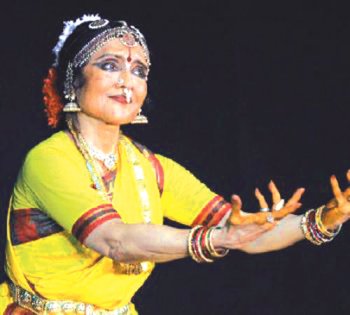
|   |

|   |
Enriching profundity and essence of abhinaya - Dr. M Surya Prasad, Bangalore e-mail: drmsuryaprasad@gmail.com June 28, 2011 Rightly captioned, the ‘Abhinayam-Anubhavam’ program, an abhinaya (enacting) focussed lecture-demonstration program held at the MES Kalavedi under the Smt. Ammanni Iyengar Endowment Birth Centenary celebration special program unveiled the subtleties of abhinaya and also demonstrated how anubhavam (experience) plays a vital role in capturing the essence of those subtleties. The artiste to author a thesis on this was none other than the dancer-diva Dr. Vyjayanthimala Bali. The rasikas were enthralled and each and every moment and the movements were sensitive and communicative. Her simple story telling technique, agility, technical clarity and precise enactment was both emotional and artistic too.  At the outset, she expressed her gratitude to her gurus in general and Guru Vazhuvoor Ramaiah Pillai in particular for equipping her with such an art and teaching her rare and gem compositions. She drove home the fact that the abhinaya is not merely a gestural language but it is the expression of intrinsic moods, rasas and the meaning of the lyrics. And that expression becomes enriching, endearing and rewarding when it is conjured up with huge lot of experience of life along with stage performances. With decades of anubhava and artistic interactions, Vyjayanthimala Bali’s abhinaya was profound, fully ripened and dignified. Whether it was a nayika, Bala Krishna, or a gopika, all of them became living entities on the stage, thanks to Vyjayanthimala’s par excellent histrionic skills. She could evoke the underlying emotions and the resultant rasas with grace, ease and poise. The added attraction was that she herself sang the compositions while translating them into a fine gestural medium. For comfortable singing, she sat down and continued to demonstrate in the seated position itself, varied compositions in different forms, composers, languages, ragas and talas with wide ranging rasas. On one hand it was a treat of some old and rare compositions and on the other, her Ekaaharya laasyanga presentation invoked all of the varied moods, characters and melodies. The lec-dem opened with Ghanam Krishna Iyer’s “Ella Arumaigalum” in Todi raga followed by Sarangapani’s ‘Maaname bhooshanamu’ (Shankarabharanam). One of the popular varnas by Dandayudapani Pillai ‘Mohamayina’ (Kharaharapriya) was gracefully delineated. She excelled in the demonstration of a padam in Khamach raga by Dharmapuri Subbarayar “Ariven Aiyya.” Her abhinaya detailing could easily picture a lovelorn nayika on the basis of “Sakhi Pranasakhuditu jesene” (Dharmapuri Subbarayar, Chenchuruti raga). The pranks of child Krishna as explicated in “Aadahodalle makkalu” by Purandaradasa set in a rainbow of ragas like Khamach, Kamavardhini, Hindola and Maand was endearing. The faithful reproduction of the text of the songs and her expertise lent authenticity for her enactment. The characterizations were thorough to the core and yet simple in sketching the theme. Uninhibited drama in the pleasing narratives marked the choreographic space of Vyjayanthimala’s abhinaya. Her hands (mudras), torso, mukhijas (facial) and saatwikaabhinaya created wonders of abhinaya. She was applauded for her excellent and succinct nritta, that too in a seated position. The Swati Tirunal tillana (Geetha dhwani ki takadheem) in Dhanashri was a befitting finale. Besides her own singing, the veteran and versatile dancer was appropriately accompanied by Gayathri Sasidharan (nattuvangam), Anahita Ravindran (vocal), Chaitanya Kumar (flute) and Shaktivel Muruganandam (mridangam). Dr. M Surya Prasad is a renowned musicologist, columnist and art critic. He is a Professor and Head of the Dept. of Hindi at Vijaya Degree College, Bangalore. He is the editor of Gunagrahi, a journal in English on music and dance. |